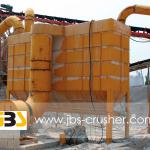Cyclone dust collector
| Condition:New | Type:Other | After-sales Service Provided:Overseas third-party support available |

| 1.XLP / B-type (formerly the CLP / B) is a highly-efficient cyclone dust collector with bypass dry. 2.XLP / B cyclone dust collector is divided into X-type (inhalation) and Y (press -) X-type according to different positions of the fan. As for the X-type, exports spiral shell is added in the dust collector body. X,Y type are divided into sub-N-type (left rotation) and S-type (right rotation).under the direction of rotation of the spiral shell 3.The cyclone dust collector is used to remove non-cementation of dust, coal, sand, dust and other dust. 4.The cyclone dust removal equipment is designed according to the the number and nature of the dust brought about in the production plant, and requirements for processing the dust. Installed and combined by the centrifugal fan and the muffler. | ||||||||||||||||||||||||||||||||||||||||||||||||||||
| 1, A cyclone dust collector stability and operating parameters | ||||||||||||||||||||||||||||||||||||||||||||||||||||
1.1 The inlet velocity | ||||||||||||||||||||||||||||||||||||||||||||||||||||
| 1.2 dust physical properties of gases and intake status The physical properties of the dusty gas affecting the cyclone dust collector performance is the gas density and viscosity. The dust density of the gas inlet t is decreased with the inlet temperature increased and it is increased with the inlet pressure increased. The greater the critical particle size is, so that the dust removal efficiency is decreased. However, when the density of the gas is compared with the dust density, especially at low pressure, it is almost negligible, so, the dust removal efficiency and the dust density is negligible. On the other hand, the smaller the density of the gas is , the smaller the pressure drop is. Cyclone efficiency decreases with the increase of gas viscosity, gas viscosity changes directly related to changes in temperature, when the gas temperature increases, the gas viscosity increases, so the increase of the particle by the centripetal force, so a certain wind speed at the entrance precipitator efficiency decreases with increasing temperature. Dust collector, running in the high temperature conditions should have a larger inlet velocity and a smaller cross-section gas velocity, which should also run with cyclone management attention. | ||||||||||||||||||||||||||||||||||||||||||||||||||||
| 1.3 gas dust concentration Gas dust concentration on cyclone dust collector has an impact on the efficiency and pressure loss. The experimental results show that the pressure loss caused by dealing with dusty gas is smaller than dealing with clean air, and the pressure loss decreases with the increase of the dust load, this is because the radial motion of a large number of dust particles drag a lot of air; The dust moves outward from the airflow with higher speed to the airflow with lower speed., transferring the energy to the outer layer of the rotating air flow, reducing the pressure of their needs, thereby reducing the pressure loss. The efficiency of the cyclone collection will be enhanced with the increase of the dust concentration. But the speed of improving the removal efficiency is much slower than that of the increase in dust concentration and therefore, according to the dust concentration, the gas flow and speed will be continuously adjusted. And always guarantee a higher rate of dust removal. When choosing the capacity of the dusty gas, the bond strength and adhesive of dust must be considered in addition to the dust concentration. When used for the purification of the medium bond dust, dusty gas capacity should be 1/4 of the allowed capacity, when used for higher bonding dust purification, capacity of the dusty gas should be 1/8 of the allowed capacity, to ensure t he reliability of the equipment . | ||||||||||||||||||||||||||||||||||||||||||||||||||||
| 1.4 the physical properties of solid dust Physical properties of solid dust are the particle size, density and dust particle size distribution is an important factor affecting the cyclone dust collector. The larger the particle size in the dust stream is, the greater the centrifugal force generated in the cyclone dust collector is, and is beneficial for separation. Therefore, the greater the percentage of the large particles of dust is , the higher the dust removal efficiency is The size of the particle density directly affects the critical diameter. The larger the particle density, the smaller the critical diameter, the higher the dust removal efficiency. However, the influence of particle density on the pressure loss is small and it can be neglected in design calculations. When the coarse particles corrosive dust is handled, its concentration is lower than the allowable concentration by 1/2 ~ 1/3, for a pre-precipitator design. When dealing with corrosive dust, you must increase the wall thickness of the dust collector or cover rubber sheet under the , cyclone dust ,artificial stone and other corrosion-resistant materials. | ||||||||||||||||||||||||||||||||||||||||||||||||||||
| 1.5 moisture content The dust content has a great impact on the dust conditions of the gas cyclone. If the dust has high dispersion and small adhesion, gas purification in the cyclone dust collector is not good. If the amount of fine particles is unchanged, an increased by 5% to 10% moisture content, particle mutual bond is relatively large in the cyclone dust collector, these particles are punched fiercely on the wall, so the gas purification will be greatly improved. So add some steam to the precipitator to improve the efficiency of the approach. But it is important to note that the amount of water vapor should not be too large, because it will cause the dust sticky wall, and even blocked, resulting in greatly reduced performance of the cyclone. | ||||||||||||||||||||||||||||||||||||||||||||||||||||
| In addition to the factors above affecting the performance of cyclone dust collector, the dust collector inner wall roughness also affect the performance of the precipitator. | ||||||||||||||||||||||||||||||||||||||||||||||||||||
XLP/B type cyclone
| ||||||||||||||||||||||||||||||||||||||||||||||||||||

| Packaging Detail:seaworthy package |
| Delivery Detail:30 days after payment |














